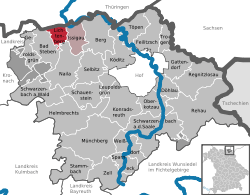Lichtenberg, Bavaria
| Lichtenberg | ||
|---|---|---|
| ||
 Lichtenberg | ||
Location of Lichtenberg within Hof district  | ||
| Coordinates: 50°22′N 11°40′E / 50.367°N 11.667°ECoordinates: 50°22′N 11°40′E / 50.367°N 11.667°E | ||
| Country | Germany | |
| State | Bavaria | |
| Admin. region | Oberfranken | |
| District | Hof | |
| Municipal assoc. | Lichtenberg | |
| Government | ||
| • Mayor | Elke Beyer (SPD) | |
| Area | ||
| • Total | 9.47 km2 (3.66 sq mi) | |
| Population (2013-12-31)[1] | ||
| • Total | 1,040 | |
| • Density | 110/km2 (280/sq mi) | |
| Time zone | CET/CEST (UTC+1/+2) | |
| Postal codes | 95192 | |
| Dialling codes | 09288 | |
| Vehicle registration | HO | |
| Website |
www.lichtenberg -oberfranken.de | |
Lichtenberg is a town in northeastern Bavaria, lying in the district of Hof in Upper Franconia.
It lies on a hill above the valley of the river Selbitz, in the Frankenwald nature park.
In association with the Upper Franconian government, Lichtenberg is the location of "Haus Marteau", an international music conference center named after the violinist Henri Marteau, a resident of the town. The center offers courses for conductors all year.
History
The town's origins reach back to the 9th century. New and expanded buildings were built and occupied by the dukes of Meranien in the 12th century. The counts of Orlamünde inherited the town in 1248. First mention of the town and its recognition as an independent municipality came in 1337.
During the Cold War division of Germany (1945-1990), Lichtenberg lay only a kilometer from the inner German border, on the western side.
Medieval fair
Each September, the Friends of Lichtenberg Castle hold a festival in the ruins of the castle.
References
- ↑ "Fortschreibung des Bevölkerungsstandes". Bayerisches Landesamt für Statistik und Datenverarbeitung (in German). 31 December 2013.
